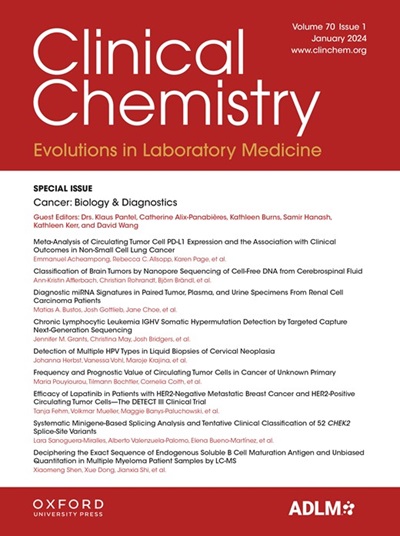B-316 在自动分析仪上评估经 FDA 批准的色粒素 A 检测方法
IF 7.1
2区 医学
Q1 MEDICAL LABORATORY TECHNOLOGY
引用次数: 0
摘要
背景嗜铬粒蛋白 A(CgA)是一种亲水性酸性蛋白,存在于神经内分泌细胞的嗜铬粒颗粒中。它是监测神经内分泌肿瘤(NETS)的首选肿瘤标记物,这些肿瘤通常出现在肺、阑尾、胰腺和胃肠道。以前的 CgA 检测是通过手工 ELISA 检测进行的,没有获得 FDA 批准,因此需要更长、更严格的验证过程和更长的运行时间。引入经 FDA 批准的自动 CgA 检测方法后,实验室可以更快、更可靠地处理患者样本,将多小时的处理过程缩短到几分钟。本研究的目的是评估最近通过 FDA 认证的自动 CgA 检测方法的性能。方法 我们在自动 B-R-A-H-M-S KRYPTOR Compact PLUS(赛默飞世尔科技公司)上验证了 B-R-A-H-M-S™ Chromogranin A II (CGAII) 检测法。CGAII 检测法是一种免疫荧光检测法,使用时间分辨放大隐色发射(TRACE)来定量检测人血清中的 CGA。对测定的性能特征进行了评估,包括测量范围(MR)和最大稀释度、精密度、方法比较、稳定性、参考区间、稳定性和迁移率。结果 通过对 8 个浓度水平(25.8 - 2,700 纳克/毫升)的血清进行一式三份分析,确定了 CGAII 的最大测量范围。线性斜率为 0.907,截距为 1.948,观察误差为 2.54 纳克/毫升。各点的回收率在 83.3-110.3% 之间。在浓度约为 MR 上限的 2 倍时,未观察到残留(<5.0 纳克/毫升)。1:25或1:500的自动稀释被认为是可以接受的(偏差% <16%)。在浓度为 56.7 和 393.0 纳克/毫升时,日内精密度变异系数 (CV) 为 4.1-1.7%(SD 为 2.32-6.64 纳克/毫升)。在浓度为 57.5 和 403.8 纳克/毫升时,日间变异系数为 6.0-7.1%(标准差为 3.43 - 28.84 纳克/毫升)。采用类似的方法,将浓度范围为 56.4-2,907 纳克/毫升的 20 个样本与参考实验室进行了比较。相关系数为 0.9934,斜率为 1.014,截距为 -32.95。将另外 20 份浓度范围为 67.0-2,446 纳克/毫升的样品与 CgA 酶联免疫吸附试剂盒(CGA-ELISA-NG,CISBIO)进行比较,以确定两种方法之间的偏差。相关系数为 0.9902,斜率为 0.845,截距为 -15.31,偏差为 -19.9%。血清样本在 2-8°C下保存 3 天后保持稳定。在 2-8°C 下保存第 3 天后,回收的 CgA 浓度超出 95% 置信区间。制造商提供的参考区间为 <187 ng/mL,通过检测 20 份健康成人样本进行了验证,所有样本均在此范围内。结论 经验证,该检测方法是一种准确、精确的 CgA 监测方法。此外,该方法还在自动分析仪上进行了验证,以缩短核心实验室的周转时间。本文章由计算机程序翻译,如有差异,请以英文原文为准。
B-316 Evaluation of an FDA-cleared Chromogranin A Assay on an Automated Analyzer
Background Chromogranin A (CgA) is a hydrophilic and acidic protein, present in the chromaffin granules of neuroendocrine cells. It is the preferred tumor marker for the monitoring of neuroendocrine tumors (NETS), which are often found in the lungs, appendix, pancreas, and gastrointestinal tract. Previous CgA assays were performed by manual ELISA testing, and were not FDA-approved, leading to a longer, more rigorous validation process and longer run times. The introduction of an automated, FDA-cleared CgA assay allows the laboratory to process patient samples more quickly and reliably, shortening a multiple hour process to minutes. The objective of this study was to evaluate the performance of an automated CgA assay recently cleared by the FDA. Methods We validated the the B·R·A·H·M·S™ Chromogranin A II (CGAII) assay on the automated B·R·A·H·M·S KRYPTOR Compact PLUS (Thermo Fisher Scientific Inc.). The CGAII assay is an immunofluorescent assay, which uses Time-Resolved Amplified Cryptate Emission (TRACE) to quantitate CGA in human serum. Assay performance characteristics were evaluated including measuring range (MR) and maximum dilution, precision, method comparison, stability, reference interval, stability, and carryover. Results The MR for CGAII was established with triplicate analysis of serum at 8 levels, ranging from 25.8 - 2,700 ng/mL. Linearity was demonstrated with a slope of 0.907, intercept of 1.948 and observed error of 2.54 ng/mL. Recovery at each point ranged from 83.3-110.3%. Carryover (<5.0 ng/mL) was not observed at a concentration approximately 2 times the upper limit of the MR. A 1:25 or 1:500 automatic dilution was determined to be acceptable (% bias <16%). Intraday precision coefficient of variation (CV) ranged from 4.1-1.7% (SDs from 2.32-6.64 ng/mL) at concentrations of 56.7 and 393.0 ng/mL. The interday CVs ranged from 6.0-7.1% (SDs from 3.43 - 28.84 ng/mL) at concentrations of 57.5 and 403.8 ng/mL. Twenty samples with concentrations ranging from 56.4-2,907 ng/mL were compared to a reference laboratory utilizing a similar methodology. The correlation coefficient was 0.9934, with a slope of 1.014, and intercept of -32.95. An additional twenty samples with concentrations ranging from 67.0-2,446 ng/mL were compared to a CgA ELISA kit (CGA-ELISA-NG, CISBIO) to determine the bias between the two methodologies. The correlation coefficient was 0.9902, with a slope of 0.845, and intercept of -15.31, and a bias of -19.9%. The serum samples were stable for 3 days when stored at 2-8°C. Recovered CgA concentrations fell outside of the 95% confidence interval after day 3 at 2-8°C. The manufacturer provided reference interval of <187 ng/mL was verified by testing 20 healthy adult samples, all of which fell within this range. Conclusions This assay has been validated and shown to be an accurate and precise method for monitoring CgA. Further, the method was validated on an automated analyzer to allow expeditious turnaround time in a core laboratory.
求助全文
通过发布文献求助,成功后即可免费获取论文全文。
去求助
来源期刊

Clinical chemistry
医学-医学实验技术
CiteScore
11.30
自引率
4.30%
发文量
212
审稿时长
1.7 months
期刊介绍:
Clinical Chemistry is a peer-reviewed scientific journal that is the premier publication for the science and practice of clinical laboratory medicine. It was established in 1955 and is associated with the Association for Diagnostics & Laboratory Medicine (ADLM).
The journal focuses on laboratory diagnosis and management of patients, and has expanded to include other clinical laboratory disciplines such as genomics, hematology, microbiology, and toxicology. It also publishes articles relevant to clinical specialties including cardiology, endocrinology, gastroenterology, genetics, immunology, infectious diseases, maternal-fetal medicine, neurology, nutrition, oncology, and pediatrics.
In addition to original research, editorials, and reviews, Clinical Chemistry features recurring sections such as clinical case studies, perspectives, podcasts, and Q&A articles. It has the highest impact factor among journals of clinical chemistry, laboratory medicine, pathology, analytical chemistry, transfusion medicine, and clinical microbiology.
The journal is indexed in databases such as MEDLINE and Web of Science.
 求助内容:
求助内容: 应助结果提醒方式:
应助结果提醒方式:


